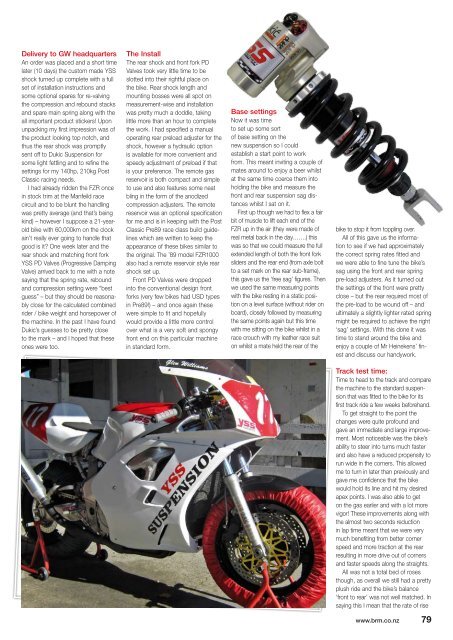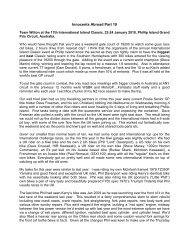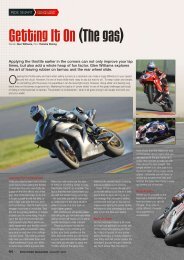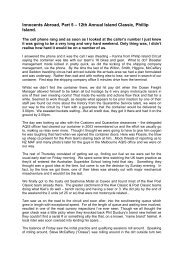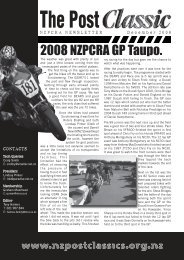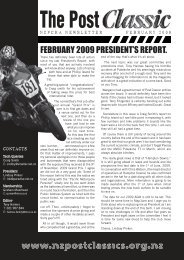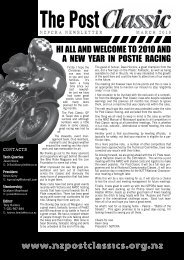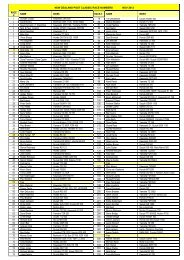SUSPENSION YSS - Glen Williams
SUSPENSION YSS - Glen Williams
SUSPENSION YSS - Glen Williams
Create successful ePaper yourself
Turn your PDF publications into a flip-book with our unique Google optimized e-Paper software.
Delivery to GW headquartersAn order was placed and a short timelater (10 days) the custom made <strong>YSS</strong>shock turned up complete with a fullset of installation instructions andsome optional spares for re-valvingthe compression and rebound stacksand spare main spring along with theall important product stickers! Uponunpacking my first impression was ofthe product looking top notch, andthus the rear shock was promptlysent off to Dukic Suspension forsome light fettling and to refine thesettings for my 140hp, 210kg PostClassic racing needs.I had already ridden the FZR oncein stock trim at the Manfeild racecircuit and to be blunt the handlingwas pretty average (and that’s beingkind) – however I suppose a 21-yearoldbike with 60,000km on the clockain’t really ever going to handle thatgood is it? One week later and therear shock and matching front fork<strong>YSS</strong> PD Valves (Progressive DampingValve) arrived back to me with a notesaying that the spring rate, reboundand compression setting were “bestguess” – but they should be reasonablyclose for the calculated combinedrider / bike weight and horsepower ofthe machine. In the past I have foundDukic’s guesses to be pretty closeto the mark – and I hoped that theseones were too.The InstallThe rear shock and front fork PDValves took very little time to beslotted into their rightful place onthe bike. Rear shock length andmounting bosses were all spot onmeasurement-wise and installationwas pretty much a doddle, takinglittle more than an hour to completethe work. I had specified a manualoperating rear preload adjuster for theshock, however a hydraulic optionis available for more convenient andspeedy adjustment of preload if thatis your preference. The remote gasreservoir is both compact and simpleto use and also features some neatbling in the form of the anodizedcompression adjusters. The remotereservoir was an optional specificationfor me and is in keeping with the PostClassic Pre89 race class build guidelineswhich are written to keep theappearance of these bikes similar tothe original. The ’89 model FZR1000also had a remote reservoir style rearshock set up.Front PD Valves were droppedinto the conventional design frontforks (very few bikes had USD typesin Pre89!) – and once again thesewere simple to fit and hopefullywould provide a little more controlover what is a very soft and spongyfront end on this particular machinein standard form.Base settingsNow it was timeto set up some sortof base setting on thenew suspension so I couldestablish a start point to workfrom. This meant inviting a couple ofmates around to enjoy a beer whilstat the same time coerce them intoholding the bike and measure thefront and rear suspension sag distanceswhilst I sat on it.First up though we had to flex a fairbit of muscle to lift each end of theFZR up in the air (they were made ofreal metal back in the day…….) thiswas so that we could measure the fullextended length of both the front forksliders and the rear end (from axle boltto a set mark on the rear sub-frame),this gave us the ‘free sag’ figures. Thenwe used the same measuring pointswith the bike resting in a static positionon a level surface (without rider onboard), closely followed by measuringthe same points again but this timewith me sitting on the bike whilst in arace crouch with my leather race suiton whilst a mate held the rear of thebike to stop it from toppling over.All of this gave us the informationto see if we had approximatelythe correct spring rates fitted andwe were able to fine tune the bike’ssag using the front and rear springpre-load adjusters. As it turned outthe settings of the front were prettyclose – but the rear required most ofthe pre-load to be wound off – andultimately a slightly lighter rated springmight be required to achieve the right‘sag’ settings. With this done it wastime to stand around the bike andenjoy a couple of Mr Heinekens’ finestand discuss our handywork.Track test time:Time to head to the track and comparethe machine to the standard suspensionthat was fitted to the bike for itsfirst track ride a few weeks beforehand.To get straight to the point thechanges were quite profound andgave an immediate and large improvement.Most noticeable was the bike’sability to steer into turns much fasterand also have a reduced propensity torun wide in the corners. This allowedme to turn in later than previously andgave me confidence that the bikewould hold its line and hit my desiredapex points. I was also able to geton the gas earlier and with a lot morevigor! These improvements along withthe almost two seconds reductionin lap time meant that we were verymuch benefiting from better cornerspeed and more traction at the rearresulting in more drive out of cornersand faster speeds along the straights.All was not a total bed of rosesthough, as overall we still had a prettyplush ride and the bike’s balance‘front to rear’ was not well matched. Insaying this I mean that the rate of risewww.brm.co.nz 79


